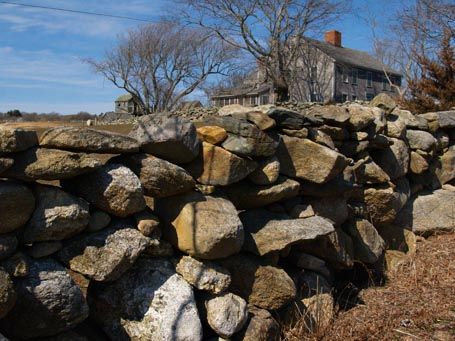
This casually stacked old, field-stone wall ambles across a classic New England farm demarcating fields. The stone selection and placement appears somewhat ad hoc, but beautifully so. Gaps, between smaller rocks toward the top of this jumble and larger rocks beneath them, let daylight penetrate the upper courses, almost cheerfully defying the mass of the wall. It lumbers along performing its function while inspiring awe. It reflects an artful intervention of human will on a weighty natural material. The appeal is almost visceral. For more insight into the art of working with stone take a look at Dan Snow’s In the Company of Stone and Lew French’s Stone by Design.
by Katie Hutchison for House Enthusiast and SquareOne
Read more design snapshots by architect Katie Hutchison.
Fine Homebuilding Recommended Products
Fine Homebuilding receives a commission for items purchased through links on this site, including Amazon Associates and other affiliate advertising programs.

Code Check 10th Edition: An Illustrated Guide to Building a Safe House

The New Carbon Architecture: Building to Cool the Climate

Pretty Good House































View Comments
I too see the ad hoc beauty in this type of stone wall but can't help but wonder what the determined souls who stacked each and every one of those boulders with a grunt and a snort would think of us contemplating it as art. Regardless, their strain is our gain in admiring the enduring result of their effort.
Nice photo, Katie. I agree, the daylight passing through those upper courses of stone is beautiful in some way.
ThetimberTailor: I agree with you as well. I can't imagine clearing a field of stone and then building a wall with such thought. Undoubtedly thought was put into this wall. The stones weren't just thrown about.
Brian, the editor here at the magazine informed me that this is a classic example of a "lace wall". It's a common style along the New England Coast. According to a NYtimes article, lace walls were sometimes used to keep sheep contained in pasture. Because the top stones would fall easily, sheep tended to keep off of them.
It's a good article and worth a read. Here is a link:
http://travel.nytimes.com/2005/11/18/travel/escapes/18stone.html?pagewanted=all
I'm so glad to learn the term "lace wall" and the pragmatic thinking behind it. Thanks, Rob, Brian, and TheTimberTailor.